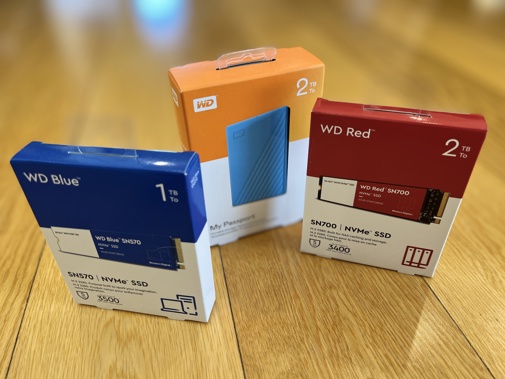
Well this is exciting.
It's been a fair old while since I upgraded the storage in a computer.
I still recall the first time I attempted this on a desktop PC many years ago. All I wanted was a bit of extra space for my music and photos, yet I was blown away how the installation of a larger, newer hard drive boosted almost every aspect of that computer's performance; boot time was slashed dramatically, apps launched faster, it was like a having a whole new machine.
Best of all, it was a pretty easy thing to do. Unlike a RAM upgrade or swapping out a graphics card, back in those days replacing a hard drive was simply a matter of opening up your PC cabinet, sliding the new drive in place, plugging it in then running some cloning software to copy your info across. Easy.
Time consuming, sure. But easy.
Solid State Drives made this even easier; they were smaller, lighter and faster.
But in recent years things have shifted again. NVMe is the standard SSD format now. Is it still an easy upgrade?...
Thanks to Western Digital, easier than ever.
WD has a whole new range of storage options to suit everyone's needs. I've been using a selection of them over the past week or so and I'm here to tell you, bigger space at faster speeds is still the single greatest thing you can do to upgrade your computing experience.
I started with the WD Red SN700 NVMe SSD - talk about throw everything including the kitchen sink at it. This is the ultimate solution for NAS caching and storage - think network backups or perhaps shared media for a small business scenario. In simple terms, what Western Digital is going for with its Red range is high capacity, super fast storage capable of being accessed by multiple devices simultaneously.
If that sounds like something that could prove pretty useful in this brave, new hybrid working environment, you're spot on. This is the ideal storage option for teams accessing files both in the office and remotely, so obviously I decided to just bung one in my laptop and see what happens.
It goes without saying, a high-end, high-performance, ultra-durable piece of kit like the WD Red SN700 would be complete overkill for my trusty little 13-inch, several-years-old laptop but the 2TB capacity was an irresistible step up from the 500GB module I was already using. The question was; how do you actually go about swapping out an NVMe card? Have you seen them? They're smaller than a stick of gum.
If you've already done this before, you'll know I'm over-dramatising somewhat. If you haven't, the good news is Western Digital offers an idiot-proof cloning solution, courtesy of a bespoke version of Acronis True Image, easily downloadable direct from the WD website. In fact, WD offers quite a suite of software for download to compliment your new drive but we'll cover some of the other options off shortly. The main event here is copying everything from your existing primary drive to your shiny, new Western Digital NVMe.
It would be highly unusual for any laptop to offer a second space to install another drive into so you'll require some sort of USB enclosure. This is literally just a case that lets you plug in your new NVMe just like any other external storage - NVMe enclosures are widely available and fairly inexpensive.
Once you've downloaded Acronis True Image and plugged in your new drive, it's literally a matter of pushing the "Cloning" button on the app. I couldn't believe how painless the process was, even compared to the last time I did it - that involved creating a bootable version of True Image and running everything from the Windows Recovery menu. Not anymore; just plug, play and away we go.
Obviously the cloning process takes a while - but not anything like the hours I used to have to wait for back in the bad old hard drive days. Once complete, all I had to do is open up my laptop, remove the existing drive, insert the WD Red SN700 and I was good to go.
There's always a moment's nervousness when you boot up after swapping drives but in this case, the moment was short. Thanks to the incredible 3400MB/s read - 2900MB/s write performance, even booting up my laptop is faster than ever. As I expected, games and other programs also load faster and of course, with 2TB of storage I now have plenty of space to load quite a library of games directly onto my local drive, as opposed to the external storage I was using before.
The Red SN700 comes in a range of sizes, right up to 4TB. It's not cheap - but then remember, this really is top of the line, designed for some pretty brutal use cases.
Perhaps a more budget-friendly alternative is the WD Blue SN570. There's no 4TB option here - the range starts at 250GB and goes up to 2TB - but you still get lightning-fast read and write speeds. Given I'd already upgraded my laptop with the Red SN700 drive, I decided to leave my 1TB Blue SN570 in the USB enclosure and set it up as a media server for everyone to access at home.
This is where some of Western Digital's other downloads came in handy - especially for my iMac. Now you may be thinking, "What's he talking about? You can't use drives like these with a Mac. Certainly not if they're formatted as NTFS."
Well, that's what I thought anyway. F.Y.I. NTFS is how PC storage is organised for efficient transfer of files - especially large ones like video files. To my surprise, it turns out you just need the right tools for the job and the Western Digital website offers plenty of tools, including drivers to make NTFS devices discoverable on a Mac. In next to no time I had my media files transferred to the Blue SN570 and was streaming them all over the house via Plex Server. Yay.
Then again, if you just want a good, old-fashioned external device for backups and the like, WD has got you covered there too. The My Passport portable drive requires virtually no setup at all; just plug and play using the included USB cable. While the write speeds don't quite match those of the NVMe cards, the storage capacity is what it's all about - starting from 1TB all the way up to 5TB. Best of all, the WD Discovery app for both PC and Mac is already pre-installed on the device - you don't even need to download it.
That's just a sample of the latest storage options from Western Digital but as you can see, there's something for everyone, featuring huge capacities, excellent speeds and an impressive line-up of software utilities to get your drive working the way you need it to as efficiently as possible. One thing hasn't changed; upgrading your drive is still easy and still the quickest way to give your computer a new lease on life.
Take your Radio, Podcasts and Music with you














